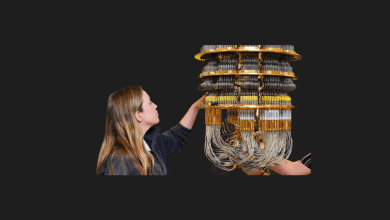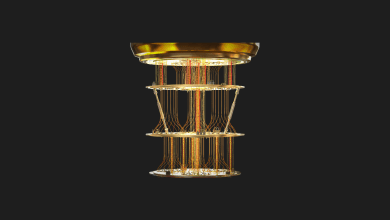Quantum Teleportation: Fact or Fiction?

Global digital communications rely on fast, efficient data transmission at the speed of light through a complex network of optical fibers. This system works perfectly for classical computing that processes binary data—0s and 1s. However, as quantum computing becomes increasingly important for encryption, scientific research, and many other applications, a new question arises: How can quantum data be transferred directly from one quantum computer to another?
The Rise of Quantum Technologies

Bridging Classical and Quantum Communication
For a long time, researchers believed that transferring quantum information was nearly impossible because every quantum computer was thought to be isolated. This inherent isolation severely limited the potential of quantum computing. Now, thanks to novel scalable quantum chip designs and innovative research from teams at Northwestern University, Ciena Corporation, and NuCrypt LCC, scientists have demonstrated that a quantum state can be preserved and transmitted along with the “normal” data flow in an optical fiber network.
This breakthrough is a stepping stone in our global communication infrastructure. As described in a recent publication in Optica, the experimental results suggest that the combination of quantum teleportation with classical communication methods could soon lead to highly secure and instantaneous communications—even if the physical quantum particle does not travel very far.
What Is Quantum Teleportation?

Understanding the Concept of Entanglement
Even though quantum teleportation might sound like a plot straight out of a science-fiction movie, it is a well-researched phenomenon that has been under study for decades. The process relies on a fascinating quantum effect known as entanglement. When two particles are entangled, they become linked in such a way that the state of one directly influences the state of the other—even if they are separated by great distances. In some cases, the transfer of information between these particles might even appear faster than the speed of light (a phenomenon that continues to spark debate among physicists).
“When two photons undergo a destructive measurement, where one carries the quantum state and the other is entangled with an additional photon, the quantum state is effectively transferred to the remaining photon that may be located far away. The photon itself does not need to travel long distances, yet its state is relayed across the gap.”
– Jordan Thomas, Northwestern University
The Experiment: Optical Fibers Meet Quantum Teleportation

Setting Up and Maintaining the Quantum State
It had long been assumed that no quantum state could be transferred through optical fibers because any entangled photon would lose its distinctive quantum properties amid the billions of other photons traveling simultaneously. The recent experiment challenged this belief through two critical innovations:
- Optimized Wavelength Selection:
Researchers identified a less congested light wavelength (1290 nm) ideal for creating a dedicated quantum channel. - Noise Reduction Techniques:
Special filters were added to reduce interference from regular internet traffic, thus preserving the fragile quantum state.
Even though the experimental setup looked deceptively simple, it revealed the complexity behind transmitting a quantum state simultaneously with classical data. In classical communications, signals are typically made up of millions of photons, whereas quantum information is encoded on single photons. As explained by Pr Prem Kumar, Director of the Photonic Communication and Computing Center at Northwestern University:
“In optical communications, all signals are converted to light. For classical data transmissions, millions of photons are involved, but when it comes to quantum computing, it is all about those single photons.”
Future Prospects in Quantum Communication

Expanding Networks and Enhancing Security 🚀
The initial tests were conducted on a 30 km (18.6 miles) long optical fiber carrying high-speed internet traffic. Researchers now plan to extend these trials to much longer distances, including experiments on real underground optical cables integrated into today’s global network.
In a further push toward robust quantum networks, ongoing research is exploring the use of two pairs of entangled photons. This approach—known as entanglement swapping—involves transferring entanglement from one pair of photons to another, even without direct interaction. Such protocols could pave the way for:
- Distributed Quantum Networks: Allowing secure quantum connections between geographically distant nodes.
- Enhanced Encryption: Generating secret encryption keys that are exceptionally resistant to eavesdropping.
- Quantum Repeaters: Enabling ultra-long distance quantum state transmission through periodic “renewal” of the quantum signal.
“If we select the right wavelengths, there is no need for an entirely new infrastructure—classical and quantum communications can coexist!”
– Pr Prem Kumar
Investing in Quantum Computing

Key Players in the Quantum Race
The arena of quantum computing is still developing, yet investors have started to participate through companies that are at the forefront of innovation. Two prominent companies featured in this emerging field are Alphabet Inc. and Ciena Company.
Alphabet Inc. (Google)
- Quantum Advances:
Google’s Quantum AI Laboratory and its Santa Barbara campus have been pivotal in driving quantum research. In 2019, Google claimed to have achieved quantum supremacy with the Sycamore machine—completing in 10,000 seconds what a traditional supercomputer would require 200 years to do. - Software Innovation:
Google’s contributions extend beyond hardware. The company has released an open-source software package to help researchers develop quantum algorithms, and educational initiatives (e.g., on Coursera) invite developers to master the basics of quantum error correction.
Ciena Company
- Optical Leadership:
As a global leader in optical and routing systems, Ciena played a crucial role in demonstrating quantum teleportation over optical fibers. - Global Reach:
With a strong presence in over 70 countries and controlling more than 25% of the Chinese optical market, Ciena is well positioned to capitalize on the explosion of AI-driven applications and the subsequent increase in bandwidth demand.
The table below summarizes key features of these companies:
| Feature | Alphabet Inc. | Ciena Company |
|---|---|---|
| Focus Area | Quantum hardware & software innovations | Optical networking and telecommunications |
| Key Contribution | Demonstrated quantum supremacy with the Sycamore machine | Pioneered demonstration of quantum teleportation over optical fiber |
| Market Influence | Leading cloud solutions, extensive developer resources | Dominates over 25% of the Chinese optical market |
| Future Prospects | Setting future standards in quantum programming | Leveraging strong optical network infrastructure for AI and quantum applications |
Quantum teleportation, once considered pure science fiction, has emerged as a measurable, real-world phenomenon with the potential to revolutionize secure communications. By merging optical fiber technology with quantum principles, researchers have paved the way for future networks where classical and quantum data coexist seamlessly. This breakthrough not only promises dramatic improvements in information security but also hints at a future where quantum communications drive both technological innovation and new investment opportunities.
As we continue to witness the expansion of quantum computing, both in experimental setups and in market-leading companies, the fusion of classical and quantum methods opens an exciting chapter in global communications. Stay updated on this rapidly evolving field by following our ongoing coverage and expert resources!
- Tech Mahindra Brings Quantum Computing to the Metaverse!
- Google’s New Quantum Chip Introduced
- What is Quantum Internet? How does it work? How Fast
Follow us on TWITTER (X) and be instantly informed about the latest developments…











